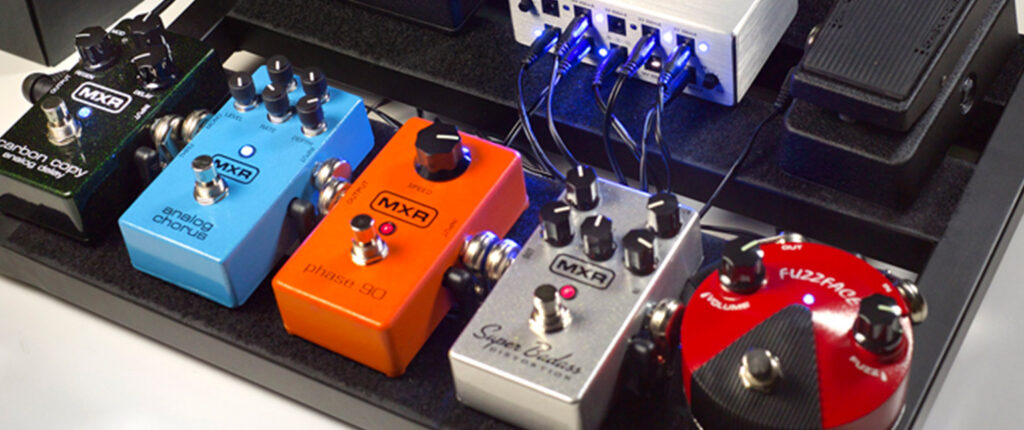Once upon a time MXR…

In 1972, Keith Barr and Terry Sherwood laid the foundations for MXR Innovations, Inc. in Rochester, New York. Their story began during their high school years at Rush-Henrietta Senior High School, where they founded Audio Services, an audio repair shop. Faced with mediocre guitar effects, Barr and Sherwood decided to create an innovative solution, giving birth to one of the giants of guitar pedals, MXR.
MXR, a contraction of “mixer”, revolutionized the world of pedals with the launch of the legendary Phase 90. Other iconic pedals followed, including the Distortion +, Dyna Comp and Blue Box. Designed to deliver high-end tones once reserved for the studio in rugged, stage-ready packages, these pedals have redefined the guitar effects landscape.

Some iconic MXR pedals

MXR Phase 90
Launched in 1974, the MXR Phase 90 was one of the first mainstream phaser pedals. Its distinctive effect attracted innovative guitarists such as Eddie Van Halen, who used it on “Eruption”, creating a swirling sound that has become emblematic of hard rock.
MXR Distortion +
Introduced in the 1970s, the MXR Distortion + played a crucial role in the evolution of the rock guitar sound. Randy Rhoads, Ozzy Osbourne’s legendary guitarist, helped sculpt the distinctive sound of heavy metal using this pedal.


MXR Dyna Comp
Launched in 1976, the MXR Dyna Comp has become a benchmark in compression. Adopted by artists such as Pink Floyd’s David Gilmour for its smooth sustain and playability, it has become a must-have on their pedalboards.
MXR Carbon Copy
Released in 2008, the MXR Carbon Copy redefined the charm of analog delay in the digital age. Acclaimed for its vintage sound, it has won over modern guitarists such as U2’s The Edge for its warm ambience.

MXR evolution and periods
MXR went through different periods, from the Reference Series (1973-1984) to the Commande Series (1981-1984) and the 2000 Series (1982-1984). The Commande Series introduced plastic pedals, while the 2000 Series marked a complete overhaul with superior quality, electronic FET switching and dual LED indicators. In 1983, MXR announced a digital sound effects generator called the Junior, adding a modern touch to its classic range.
In 1987, Jim Dunlop acquired the MXR brand, reintroducing classic pedals while continuing to innovate with new models such as the Carbon Copy and Fullbore Metal. The MXR Custom Shop was born, recreating limited-edition vintage models, including the Phase 45.

The Bass Innovations range and the MXR Custom Shop
Jim Dunlop has expanded the range with MXR Bass Innovations, offering bassists dedicated pedals such as the Bass Octave Deluxe and Bass Envelope Filter. These pedals have won Editor Awards in Bass Player Magazine and Platinum Awards in Guitar World Magazine. The MXR Custom Shop serves as a laboratory of bold ideas for the MXR team, creating unique and ambitious pedals that are fast becoming modern classics.
MXR under Jim Dunlop
Since 1987, Jim Dunlop has preserved the MXR heritage while evolving it. Reissues of classic pedals, new creations and collaborations with renowned guitaristsdemonstrate MXR’s constant diversity and innovation. The addition of classic non-MXR pedals like the Talk Box and Uni-Vibe Chorus/Vibrato demonstrates MXR’s commitment to offering a complete range of quality effects. The brand continues to push the boundaries with signature pedals and bold creations, heralding a future where musicians will find even more incredible sounds in these little boxes.

Anecdotes about the MXR brand
- MXR’s first ad, featuring the then-unknown Phase 90, simply stated, “MXR: We’re here.” Those words ring even truer on the 40th anniversary than when they were first written.
- The MXR Phase 90 phaser effect on Van Halen’s “Eruption” was created accidentally during a technical problem in the studio. The result was so impressive that the sound was retained in the final recording.
- The MXR Distortion + was the first distortion pedal used by Randy Rhoads during the recording of the “Blizzard of Ozz” album. His choice proved to be a revolutionary decision for the sound of heavy metal.
- MXR Dyna Comp is often called the “secret weapon” of recording studios, being used unobtrusively to add dynamics to many iconic recordings.
The MXR brand, born of the desire to offer guitarists superior quality effects, has left an indelible mark on the world of music. From the first pedals built in a basement to the vast range of products offered today, MXR has continued to innovate while preserving the heritage that made it famous. Whether you’re a fan of timeless classics or modern creations, MXR offers a world of sonic exploration that promises to captivate musicians for many years to come.









